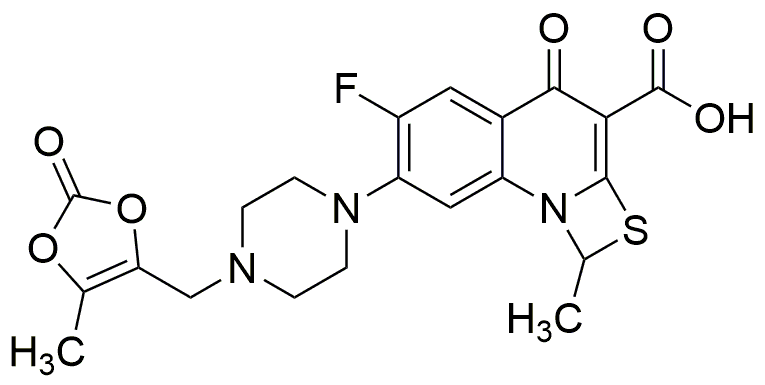Prulifloxacin is widely utilized in research focused on:
- Antibacterial Treatments: This compound is primarily used in the development of antibiotics, particularly effective against a range of bacterial infections. Its unique structure allows for a broad spectrum of activity, making it a valuable option in clinical settings.
- Pharmaceutical Formulations: In the pharmaceutical industry, prulifloxacin is incorporated into various formulations, enhancing drug delivery systems. Its solubility properties improve bioavailability, which is crucial for effective treatment outcomes.
- Veterinary Medicine: Prulifloxacin is also applied in veterinary practices to treat infections in animals. Its safety profile and effectiveness make it a preferred choice among veterinarians for managing bacterial diseases.
- Research on Resistance Mechanisms: Researchers study prulifloxacin to understand bacterial resistance mechanisms. This knowledge is essential for developing new antibiotics and improving existing treatments, addressing a significant challenge in modern medicine.
- Clinical Trials: Ongoing clinical trials often include prulifloxacin to evaluate its efficacy and safety in various populations. This research is vital for ensuring that new therapeutic options are both effective and safe for patients.
General Information
Properties
Safety and Regulations
Applications
Prulifloxacin is widely utilized in research focused on:
- Antibacterial Treatments: This compound is primarily used in the development of antibiotics, particularly effective against a range of bacterial infections. Its unique structure allows for a broad spectrum of activity, making it a valuable option in clinical settings.
- Pharmaceutical Formulations: In the pharmaceutical industry, prulifloxacin is incorporated into various formulations, enhancing drug delivery systems. Its solubility properties improve bioavailability, which is crucial for effective treatment outcomes.
- Veterinary Medicine: Prulifloxacin is also applied in veterinary practices to treat infections in animals. Its safety profile and effectiveness make it a preferred choice among veterinarians for managing bacterial diseases.
- Research on Resistance Mechanisms: Researchers study prulifloxacin to understand bacterial resistance mechanisms. This knowledge is essential for developing new antibiotics and improving existing treatments, addressing a significant challenge in modern medicine.
- Clinical Trials: Ongoing clinical trials often include prulifloxacin to evaluate its efficacy and safety in various populations. This research is vital for ensuring that new therapeutic options are both effective and safe for patients.
Documents
Safety Data Sheets (SDS)
The SDS provides comprehensive safety information on handling, storage, and disposal of the product.
Product Specification (PS)
The PS provides a comprehensive breakdown of the product’s properties, including chemical composition, physical state, purity, and storage requirements. It also details acceptable quality ranges and the product's intended applications.
Certificates of Analysis (COA)
Search for Certificates of Analysis (COA) by entering the products Lot Number. Lot and Batch Numbers can be found on a product’s label following the words ‘Lot’ or ‘Batch’.
*Catalog Number
*Lot Number
Certificates Of Origin (COO)
This COO confirms the country where the product was manufactured, and also details the materials and components used in it and whether it is derived from natural, synthetic, or other specific sources. This certificate may be required for customs, trade, and regulatory compliance.
*Catalog Number
*Lot Number
Safety Data Sheets (SDS)
The SDS provides comprehensive safety information on handling, storage, and disposal of the product.
DownloadProduct Specification (PS)
The PS provides a comprehensive breakdown of the product’s properties, including chemical composition, physical state, purity, and storage requirements. It also details acceptable quality ranges and the product's intended applications.
DownloadCertificates of Analysis (COA)
Search for Certificates of Analysis (COA) by entering the products Lot Number. Lot and Batch Numbers can be found on a product’s label following the words ‘Lot’ or ‘Batch’.
*Catalog Number
*Lot Number
Certificates Of Origin (COO)
This COO confirms the country where the product was manufactured, and also details the materials and components used in it and whether it is derived from natural, synthetic, or other specific sources. This certificate may be required for customs, trade, and regulatory compliance.


